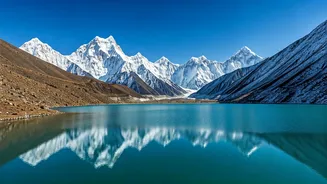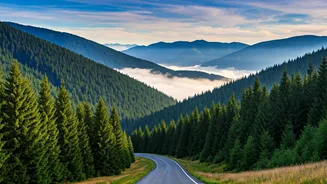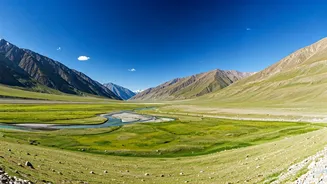Geographical Overview
Jammu and Kashmir, often referred to as 'Paradise on Earth', is a region of stunning geographical diversity, encompassing towering mountains, lush valleys,
and serene lakes. The majestic Himalayas dominate the landscape, providing a breathtaking backdrop to the region's varied ecosystems. The varied altitudes result in diverse climatic conditions, supporting a wide range of flora and fauna. The area's topography ranges from the arid high-altitude deserts of Ladakh to the fertile plains of Jammu. The mighty Indus River and its tributaries carve their path through the landscape, contributing to the region's agricultural productivity and overall beauty. This geographical variation significantly shapes the lifestyles and traditions of the people residing in the region, creating a unique cultural blend within the specific landscapes.
Kashmir Valley's Allure
The Kashmir Valley, famed for its mesmerizing beauty, is a primary draw for visitors. This valley is famous for its verdant meadows, fruit orchards, and the iconic Dal Lake. The Dal Lake, with its houseboats and shikaras, presents a picture of tranquility, inviting visitors to experience its serenity. Gardens like the Mughal Gardens showcase meticulously designed landscapes, adding to the valley's allure. The valley's climate, with its cool summers and snowy winters, further enhances its charm, creating a paradise for nature enthusiasts and photographers. The valley's rich soil supports the cultivation of various crops, including saffron, apples, and rice, which contribute to the region's economy and cultural identity. The overall experience within the Kashmir Valley offers a unique blend of natural beauty and cultural experiences, which truly captivates anyone who visits this region.
Jammu's Diverse Terrain
The Jammu region, with its diverse geography, offers a distinct experience compared to the Kashmir Valley. Jammu is characterized by its plains, foothills, and the majestic Trikuta Mountains, home to the revered Vaishno Devi shrine. The city of Jammu, often referred to as the 'City of Temples,' is a vibrant cultural center, showcasing a blend of history and modernity. The Tawi River flows through the region, enriching the land and sustaining agricultural activities. During the winter, the region experiences cooler temperatures, while the summers are generally hot. These variable climatic conditions foster the cultivation of different crops, including wheat, rice, and maize, that play an important role in the region's economy. The foothills provide opportunities for adventure sports and trekking, attracting both local and international tourists. The culture here is marked by festivals, religious observances, and a rich history, which all adds to the uniqueness of the location.
Ladakh's High Altitude
Ladakh, also known as 'The Land of High Passes,' represents an entirely different dimension within Jammu and Kashmir. Its landscape is dominated by high-altitude deserts, rugged mountains, and remote monasteries. The climate in Ladakh is harsh, with extreme temperatures and very low levels of precipitation. This challenging environment creates a unique ecosystem with specialized flora and fauna. The region is traversed by the Indus River, which is a key source of life and supports settlements. The culture of Ladakh reflects Tibetan influences, evident in its Buddhist monasteries, prayer flags, and traditional practices. The local communities have adapted to this challenging environment, developing unique survival skills and maintaining rich traditions. The region's isolation has helped preserve its distinct cultural identity, which includes captivating festivals and intricate art forms. Ladakh, therefore, stands out as a destination for travelers in search of unique experiences.
Cultural Heritage Richness
The cultural heritage of Jammu and Kashmir reflects a mosaic of influences, including Persian, Tibetan, and Central Asian. Each region presents its unique blend of traditions, languages, and lifestyles. Traditional Kashmiri handicrafts, such as Pashmina shawls, carpets, and wood carving, reflect the region's artistic prowess. The local cuisine is characterized by rich flavors, using a variety of spices, meats, and rice. Festivals, which represent an important part of the cultural tapestry, are celebrated with enthusiasm and cultural rituals. Music and dance also serve as a crucial part of the region's cultural expression, reflecting the history and way of life of the people. This blend of traditions, arts, and cuisines, showcases the rich cultural heritage and diversity that defines Jammu and Kashmir. The cultural expressions found in this region offer a glimpse into the diverse influences that have shaped this vibrant part of India.
Tourism and Attractions
Tourism is a significant sector in Jammu and Kashmir, attracting visitors from across the globe. Key attractions include the Mughal Gardens, Dal Lake, and Gulmarg in the Kashmir Valley. The Vaishno Devi shrine and the historic city of Jammu are equally significant, attracting millions of pilgrims every year. Ladakh's monasteries and stunning landscapes draw adventure seekers and cultural enthusiasts. The tourism sector creates opportunities for employment, supporting local communities and contributing to the region's economy. The natural beauty, cultural richness, and adventure activities, make Jammu and Kashmir an ideal destination for various interests. Sustainable tourism practices are important to preserve the environment and cultural heritage. The government and tourism organizations are working to improve the infrastructure, including accommodations, transport, and other facilities, ensuring a safe and comfortable travel experience.









